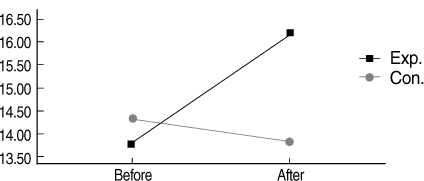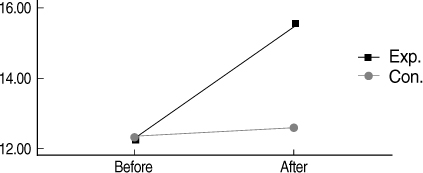J Korean Acad Nurs.
2009 Dec;39(6):829-839. 10.4040/jkan.2009.39.6.829.
Effects of Music Therapy and Rhythmic Exercise on Quality of Life, Blood Pressure and Upper Extremity Muscle Strength in Institution-Dwelling Elderly Women
- Affiliations
-
- 1Department of Nursing, Daegu Haany University, Daegu, Korea.
- 2Department of Nursing, College of Health Science, CHA University, Pocheon, Korea. kimsy@cha.ac.kr
- 3Department of Welfare for the Elderly, Daegu Haany University, Daegu, Korea.
- KMID: 1718157
- DOI: http://doi.org/10.4040/jkan.2009.39.6.829
Abstract
- PURPOSE
The purpose of this study was to determine the effects of music therapy and rhythmic exercise on health related quality of life, blood pressure and upper extremity muscle strength in the institution-dwelling elderly women. METHODS: The study was designed using a nonequivalent control group pretest-posttest design. The participants consisted of 35 elders (18 in the experimental group and 17 in the control group). The music therapy and rhythmic exercise were developed by the investigators. The experimental group took part in this program twice a week for 8 weeks. The Short Form 36 health survey questionnaire, blood pressure and grasp power scale were used as instruments. The data were analyzed using SPSS 14.0. RESULTS: Repeated measures ANOVA revealed that music therapy and rhythmic exercise had positive effects on quality of life, especially on vitality, general health and mental health. Also, there were statistically significant differences in diastolic blood pressure and upper extremity muscle strength between the pretest and posttest in the experimental group. CONCLUSION: The study suggests that this program can be applied for older women in long-term facilities to improve quality of life, blood pressure and upper extremity muscle strength.
Keyword
MeSH Terms
Figure
Cited by 3 articles
-
The Effects of Exercise in the Frail Elderly
Young-Im Park, Kang-Yi Lee, Tae-Im Kim, Moung-Hee Jeon, Dong-Oak Kim, Ji-Hyun Kim
J Korean Acad Community Health Nurs. 2012;23(1):91-101. doi: 10.12799/jkachn.2012.23.1.91.The Effects of Exercise in the Frail Elderly
Young-Im Park, Kang-Yi Lee, Tae-Im Kim, Moung-Hee Jeon, Dong-Oak Kim, Ji-Hyun Kim
J Korean Acad Community Health Nurs. 2012;23(1):91-101. doi: 10.12799/jkachn.2012.23.1.91.Effects of a Cognition Activation Program for the Institutionalized Old-Old in Korea
Hung Sa Lee, Dohyun Lee
J Korean Acad Community Health Nurs. 2013;24(4):427-437. doi: 10.12799/jkachn.2013.24.4.427.
Reference
-
1. What is music therapy? American Music Therapy Association. 2005. 03. 07. Retrieved July 7, 2009. from http://www.musictherapy.org/faqs.html.2. Choi JH, Kwon BY, Lee GM. Physical dimensions of aging. 2000. Seoul: Jungdam.3. Chung MS. Quality of life in the elderly living in the community and in institutions. The Korean Journal of Development Psychology. 2007. 20:145–169.4. Cohen J. Statistical power analysis for the behavioral sciences. 1988. Hillsdale, NJ: Lawrence Erlbaum Associates.5. Cook JD. Music as an intervention in the oncology setting. Cancer Nursing. 1986. 9:23–28.6. Heber L. Dance movement: A therapeutic intervention for psychiatric clients. Perspectives in Psychiatric Care. 1993. 29(2):22–29.7. Hopkins DR, Murrah B, Hoeger WW, Rhodes RC. Effect of low-impact aerobic dance on the functional fitness of elderly women. The Gerontologist. 1990. 30:189–192.8. Jeon MY, Choe MA. Effect of Korean traditional dance movement on psychophysiological variables in elderly Korean women. Journal of Korean Academy of Adult Nursing. 1996. 26:833–852.9. Jo K, Lee HJ. Factors related to life satisfaction in young- old, old, oldest-old women. Journal of Korean Academy of Nursing. 2009. 39:21–32.10. Kim CK, Lee WY, Bae YJ, Kim HS. A changes of the upper and lower extremity muscle function in the elderly. Exercise Science. 2000. 9:405–415.11. Kim KB, Kim IS, Jeong MY, Oh HK, Kwon YS, Lee EJ, et al. The effect of the musical therapy on depression and quality of life in the institutional elderly. Journal of Korea Gerontological Nursing Society. 1999. 1:213–223.12. Kim SH. A meta-analysis of literature on the effects of music therapy outcome research. Korean Journal of Music Therapy. 2002. 4(2):19–40.13. Kim SJ, Hwang JU, Lee SH. Accuracy of the sphygmomanometer for measuring of blood pressure. Journal of Korean Academy of Family Medicine. 1997. 18:1500–1507.14. Koh SB, Chang SJ, Kang MG, Cha BS, Park JK. Reliability and validity on measurement instrument for health status assessment in occupational workers. Journal of Preventive Medicine and Public Health. 1997. 30:251–266.15. 2004 National survey of living status and welfare needs of the elderly. Korea Institute of Health and Social Affairs. 2005. 02. 18. Retrieved October 20, 2008. from http://www.mw.go.kr.16. 2008 National survey of living status and welfare needs of the elderly. Korea Institute of Health and Social Affairs. 2009. 07. 13. Retrieved July 20, 2009. from http://www.mw.go.kr.17. Lee SH, Kim SH, Jung MH, Kim YS. The effects of music therapy on the quality of life of stroke patient. Journal of Welfare for the Aged. 2008. 41:205–234.18. Lee SJ. An application effect of rhythmic movement program for the health promotion in the elderly. Journal of Korean Academy of Nursing. 2000. 30:776–790.19. Lee WY. The effect of rhythm for life music therapy program for the health promotion in the elderly. 2003. Seoul: Chung Ang University;Unpublished doctoral dissertation.20. Lim YM. Effects of movement/exercise on physical and emotional functioning in elders with cognitive impairments. Journal of the Korean Gerontological Society. 2002. 21:197–211.21. McCaffrey R, Freeman E. Effect of music on chronic osteoarthritis pain in older people. Journal of Advanced Nursing. 2003. 44:517–524.22. Park MJ, Jung Y. The effect of music therapy on the elderly people's depression and life-satisfaction. Journal of Korean Academy of Community Health Nursing. 2005. 16:241–248.23. Shin MG, Cho WS. Human physiology. 1997. Seoul: Hyunmoonsa.24. Sorrell JA, Sorrell JM. Music as a healing art for older adults. Journal of Psychosocial Nursing and Mental Health Services. 2008. 46(3):21–24.25. Sung KW. The effect of a health maintenance program on physical function and mental health of the elderly in nursing homes. Journal of Korean Academy of Nursing. 2007. 37:478–489.26. Sung KW, Kim MH. Self-care behaviors and depressive symptoms of low-income elderly women with hypertension. Journal of Korean Academy of Nursing. 2008. 38:593–602.27. Ware JE, Sherbourne CD. The MOS 36-item shortform health survey (SF-36): Conceptual framework and item selection. Medical Care. 1992. 30:473–483.28. Yang YJ. Exercise in the elderly. Journal of the Korean Geriatrics Society. 2002. 6:Suppl. 1. 317–324.
- Full Text Links
- Actions
-
Cited
- CITED
-
- Close
- Share
- Similar articles
-
- Effects of a Music Therapy Program on Depression, Balance, Flexibility in the Elderly
- The Mediating Effect of Depression in the Relationship between Muscle Strength of Extremities and Falls among Community-Dwelling Elderly
- Effects of Rhythmic Exercise Program on the Perceived Health Status, Depression, Life Satisfaction and Physical Strength in Elderly
- The Effect of Exercise on Cardiovascular and Musculoskeletal Variables and Quality of Life in Elderly Women
- The Development of Integrative Exercise Program for the Elderly








